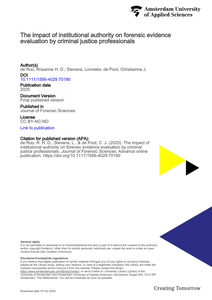Accurate and reliable decision-making in the criminal justice system depends on accurate expert reporting and on the correct interpretation of evidence by the judges, prosecutors, and defense lawyers. The present study aims to gain insight into the judiciary's capability to assess the accuracy and reliability of forensic expert reports by first examining the extent to which criminal justice professionals are able to differentiate between an accurate (or sound) expert report and an inaccurate (or unsound) expert report. In an online questionnaire, 133 participants assessed both a sound and an unsound expert report. The findings show that, on average, participants were unable to significantly distinguish between sound and unsound forensic expert reports. Second, the study explored the influence of institutional authority on the evaluation of forensic expert reports. Reports that were not recognized as flawed—particularly those originating from well-known and reputable institutions—were subjected to less critical examination, increasing the risk of evaluation errors. These results suggest that the perceived institutional authority influences the assessment of forensic evidence. The study highlights the need for tools to support criminal justice professionals in evaluating forensic evidence, particularly when experts are unregistered. Recommendations include adhering to established quality standards, consulting counter-expert evaluations, improving courtroom communication, and enhancing forensic knowledge through training. Overall, the findings underscore the importance of critical evidence evaluation to reduce the risk of misinterpretation and wrongful convictions in the judicial process.
DOCUMENT

Forensic reports use various types of conclusions, such as a categorical (CAT) conclusion or a likelihood ratio (LR). In order to correctly assess the evidence, users of forensic reports need to understand the conclusion and its evidential strength. The aim of this paper is to study the interpretation of the evidential strength of forensic conclusions by criminal justice professionals. In an online questionnaire 269 professionals assessed 768 reports on fingerprint examination and answered questions that measured self-proclaimed and actual understanding of the reports and conclusions. The reports entailed CAT, verbal LR and numerical LR conclusions with low or high evidential strength and were assessed by crime scene investigators, police detectives, public prosecutors, criminal lawyers, and judges. The results show that about a quarter of all questions measuring actual understanding of the reports were answered incorrectly. The CAT conclusion was best understood for the weak conclusions, the three strong conclusions were all assessed similarly. The weak CAT conclusion correctly emphasizes the uncertainty of any conclusion type used. However, most participants underestimated the strength of this weak CAT conclusion compared to the other weak conclusion types. Looking at the self-proclaimed understanding of all professionals, they in general overestimated their actual understanding of all conclusion types.
DOCUMENT

This chapter explores the legal and moral implications of the use of data science in criminal justice at two levels: police surveillance and the criminal trial of a defendant. At the first level, police surveillance, data science is used to identify places and people at high risk of criminal activity, allowing police officers to target surveillance and take proactive measures to try to prevent crime (predictive policing). At the second level, the criminal trial of a defendant, data science is used to make risk assessments to support decisions about bail, sentencing, probation, and supervision and detention orders for high-risk offenders. The use of data science at these levels has one thing in common: it is about predicting risk. The uncertainty associated with risk prediction raises specific related legal and ethical dilemmas, for example in the areas of reasonable suspicion, presumption of innocence, privacy, and the principle of non-discrimination.
DOCUMENT